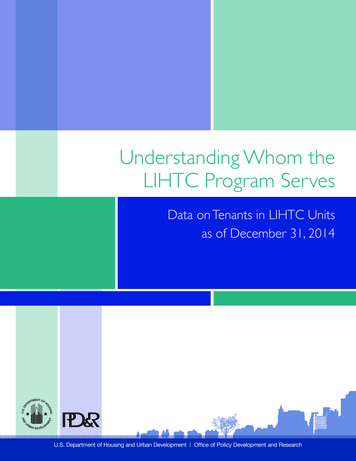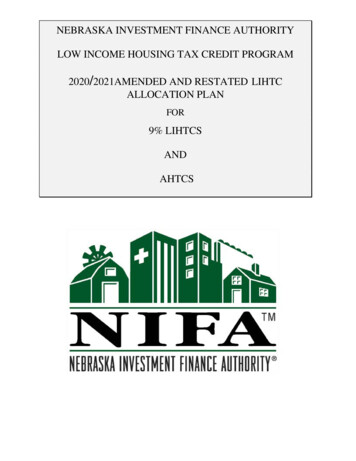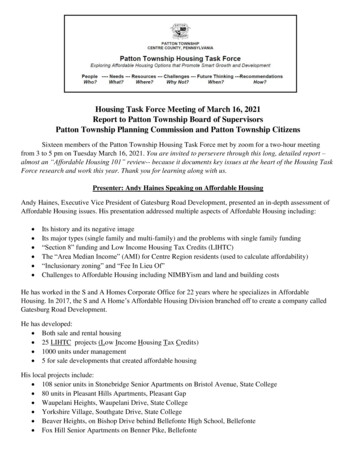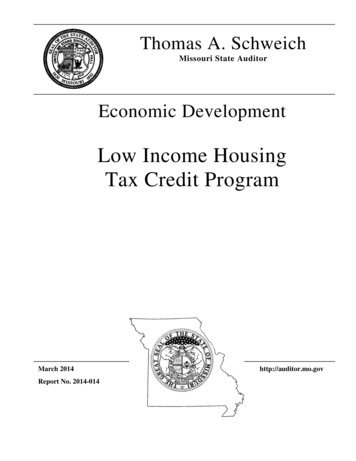
Transcription
Understanding Whom theLIHTC Program ServesData on Tenants in LIHTC Unitsas of December 31, 2014U.S. Department of Housing and Urban Development Office of Policy Development and Research
Understanding Whom theLIHTC Program ServesData on Tenants in LIHTC Unitsas of December 31, 2014Office of Policy Development and ResearchU.S. Department of Housing and Urban DevelopmentDecember 2016
ContentsI.Introduction . 1II.Comparison of 2013 and 2014 Data Submissions. 5III.Assessing Completeness of 2014 Tenant Data . 6A. States Submitting Tenant Data . 6B. Properties in the Tenant Data. 6C. LIHTC Rent-Restricted Units. 7D. Household Members. 8IV.Race and Ethnicity of Tenants . 9V.Disability Status . 11VI.Family Composition and Age . 14VII.Annual Household Income . 16VIII.Monthly Rental Payments . 19IX.Use of Rental Assistance . 21List of TablesTable 1. Comparison of 2013 and 2014 LIHTC Data Submissions . 2Table 2. Number and Percentage of Properties Matched Between Property and Tenant Databases . 3Table 3. Reported Number of Household Members Compared With Household Size at Certification . 4Table 4. Race and Ethnicity of Heads of Household . 10Table 5. LIHTC Households With Disabled Members . 12Table 6. Disability Status of Individual Household Members . 13Table 7. Family Composition: Households With Children and Elderly Members . 15Table 8. Distribution of Annual Household Income . 17Table 9. Total Annual Household Income Relative to AMGI . 18Table 10. Gross Rent as Percentage of Annual Household Income . 20Table 11. Percentage of LIHTC Households Receiving Monthly Rental Assistance . 22Table 12. Use of Federal Rental Assistance Programs in LIHTC Units . 23ii
I.IntroductionIn 2008, Congress passed the Housing and Economic Recovery Act (HERA), requiring each state housingfinance agency (HFA) that administers the Low-Income Housing Tax Credit (LIHTC) to submit certaindemographic and economic information on tenants in LIHTC units to the U.S. Department of Housing andUrban Development (HUD) according to standards determined by the Secretary of HUD. HERA specificallyrequires HFAs to submit to HUD information concerning race, ethnicity, family composition, age, income,use of rental assistance, disability status, and monthly rental payments of households residing in LIHTCproperties. This report represents the third annual data release of information collected under thismandate. More detailed background of this data collection is available in the original report,Understanding Whom the LIHTC Program Serves: Tenants in LIHTC Units as of December 31, 2012, whichis available on huduser.gov.Most of the information presented in this document was collected by the administering state HFAs aspart of program compliance enforcement. Although tenant income and rent information are collected inaccordance with specific program rules, some states have not fully adopted HUD’s standards forcollecting demographic information. Thus, although income and rent information were collected acrossstates using fairly uniform standards and definitions, the demographic information was not standardizedand, in some states, not collected at all.Finally, HUD’s administrative responsibility in the LIHTC Program is strictly limited to the designation ofDifficult Development Areas, or DDAs, and Qualified Census Tracts, or QCTs. HUD is not involved in thecompliance of LIHTC properties unless HUD subsidies are present. HUD’s collection of tenant data,although required by statute, is not used in program administration.This report represents the third public release of information under the HERA mandate. Although theinformation reported here is not inclusive of all tenants served by the LIHTC Program, it provides a usefulpicture of the program’s beneficiaries. The information presented within was received by HUD in the fallof 2015 and includes tenants in LIHTC units as of December 31, 2014. Table 1 highlights the differencesbetween the 2013 and 2014 data submissions. Tables 2 and 3 provide an assessment of property, unit,and tenant coverage by state, indicating completeness across the reporting categories. The remainingtables present the information as required by HERA with additional information on completeness aswarranted.1
Table 1. Comparison of 2013 and 2014 LIHTC Data SubmissionsHERA Housing and Economic Recovery Act. LIHTC Low-Income Housing Tax Credit. PIS LIHTC properties placed in service database.Note: The 2013 data are identical to those reported in Data on Tenants in LIHTC Units as of December 31, 2013, and do not include informationon properties placed in service prior to 2014 that was reported with the 2014 PIS data collection.a 2013 totals do not include tenant data from Illinois’ suballocator, the Chicago Department of Planning and Development, or one of New YorkCity’s suballocators, the Department of Housing Preservation & Development (HPD). 2014 totals include tenant data from the ChicagoDepartment of Planning and Development but not from the New York City HPD.2
Table 2. Number and Percentage of Properties Matched Between Property and TenantDatabasesHERA Housing and Economic Recovery Act. LIHTC low-income housing tax credit. PIS LIHTC properties placed in service database.a Does not include tenant data from the New York City Department of Housing Preservation & Development.3
Table 3. Reported Number of Household Members Compared With Household Size at CertificationabcThe District of Columbia reported household size at certification for less than one-half of its tenants.Florida, North Dakota, and Texas provided information for only one household member.Does not include tenant data from the New York City Department of Housing Preservation & Development.4
II.Comparison of 2013 and 2014 Data SubmissionsTable 1 provides a comparison of HUD’s 2013 and 2014 property and tenant data to provide a basicunderstanding of how the data presented in this report compare with data in the previous report. The2013 data presented in table 1 are identical to those reported in Data on Tenants in LIHTC Units as ofDecember 31, 2013 and do not include updated information on properties placed in service prior to 2014that was reported with the 2014 LIHTC properties placed in service (PIS) data collection. 1 The changesbetween 2013 and 2014 all represent net changes in either total properties or total units.In aggregate, there was a net increase of 1,502 active properties containing 137,158 units in HUD’s 2014LIHTC PIS database compared with the 2013 version. The highlighted rows in the first four columnsindicate states whose total property counts are less in the 2014 data than in the 2013 data. Thesedecreases solely reflect an effort to improve identification of properties that are no longer monitored forLIHTC compliance. Thus, these decreases indicate an improvement in data quality and better facilitatedata matching. For several states, however, large decreases in the number of tenants reported offset theimprovement in matching, which is shown in table 2.For the HERA-mandated tenant data, a net additional 205,298 units were reported in the 2014 datacompared with the number in the 2013 data. The increase reflects both an increase in the stock of LIHTCunits—that is, those placed in service in 2014—and newly reported information on units not submitted inthe previous collection. The highlighted rows in the last four columns indicate states whose total unitcounts are lower in the 2014 HERA data than in the 2013 data.1HFAs reported 318 LIHTC properties placed in service in 2013 with the 2014 properties. These properties were notpreviously reported.5
III.Assessing Completeness of 2014 Tenant DataThe LIHTC is administered by 60 state-level and, in limited instances, substate allocating HFAs (for simplicity,hereafter referred to as “states”). 2 Several states separate administrative functions among multiple stateagencies or local suballocators. The District of Columbia, Massachusetts, and New York separate functionsrelated to the allocation of tax credits and the issuance of tax-exempt private activity bonds between twoagencies. Compliance for all properties in the District of Columbia and Massachusetts, however, isconducted by a single agency in each state. Illinois, Minnesota, and New York allow local suballocators toaward LIHTCs in certain cities or counties. The city of Chicago has authority to award credits and administerthe program within city limits. New York City and several northern counties3 receive suballocations fromNew York State. Minnesota allows seven local governments 4 to allocate tax credits, although the statereports the tenant and property data for the entire state. 5A. States Submitting Tenant DataHUD requests tenant data and property characteristics from the 60 agencies that conduct programcompliance. HFAs administering the LIHTC in the cities of Chicago and New York did not submit 2013 tenantinformation. The 2014 data include, for the first time, data from the city of Chicago. The New York CityDepartment of Housing Preservation & Development (HPD) did not submit 2014 data and, therefore, is notincluded in the following summary tables. The following sections explain how the submitted informationmay be incomplete for each of the states.B. Properties in the Tenant DataHUD’s collection of LIHTC tenant data applies to all active LIHTC properties, including those in theextended-use period. Many states, however, were unable to submit information for all active propertiesfor several reasons. First, most states simplify or decrease the stringency of compliance rules after Year15, which lessens or eliminates certain information otherwise collected for compliance. For example,annual income recertifications may no longer be required because the Next Available Unit Rule does notapply during the extended-use period. Thus, states may not have previously maintained complianceinformation for properties in the extended-use period. Second, some states previously accepted TenantIncome Certification (TIC) forms from smaller properties in hard copy as opposed to electronicallybecause independent owners, who may not have the ability to submit electronically, manage many ofthese properties. Converting or hand-entering the information into electronic compliance and reportingsystems requires considerable time, and some states were not able to complete this type of laborintensive work. Third, HERA permits states to forgo annual income recertification of tenants if 100percent of a building’s units are income or rent restricted. Income information from tenants in2This total includes the District of Columbia, Guam, Puerto Rico, and the U.S. Virgin Islands. Aside from its use of theTax Credit Exchange Program, or TCEP, in 2009, American Samoa does not actively administer the LIHTC Programand is not counted here.3The Development Authority of the North Country administers the LIHTC Program in Jefferson, Lewis, and St.Lawrence Counties, New York.4Dakota and Washington Counties and the cities of Duluth, Minneapolis, Rochester, Saint Cloud, and Saint Paul eachreceive a portion of the state allocation.5The suballocators in Minnesota monitor for compliance and report tenant and property data to the state HFA.Beginning in the fall of 2016, however, the suballocators began reporting directly to HUD.6
these properties, therefore, may not be available or, if available, may not be current. To present anappropriate comparison, HUD’s tabulation of income relies on incomes certified in 2013, 2014, or 2015. 6One method of assessing the completeness of each state’s HERA-mandated tenant data is to compare thetotal number of properties the data contain with the number of properties reported to HUD through itsLIHTC PIS data collection, 7 summarized in table 2. The time period covered in HUD’s PIS data collection isconsistent with the tenant collection and currently includes properties placed in service through 2014.HUD’s PIS database also has known undercounting, primarily for the most recently collected placed-inservice years. 8 In addition, the PIS database also fails to correctly identify some properties that are nolonger monitored for program compliance, which inflates the true number of properties in service.Hence, the databases are not expected to be 100 percent complete and, from the data available to HUD,it is not possible to provide a definitive assessment of completeness based on one number. Rather,comparisons across the two sources of data suggest where issues of incomplete data, in either datasource, may be larger.Overall, 36,790 properties were reported as in service and monitored for LIHTC compliance in 2014. StateHFAs, however, submitted tenant information for 36,516 properties. 9 As expected, most states reportedmore properties in 2014, some with large increases. Alabama, Alaska, Illinois, and Kansas each reportedat least twice as many properties in their 2014 tenant data. Several states—Georgia, Idaho, Indiana,Maryland, Missouri, Nevada, and New Jersey—reported fewer properties than in their previoussubmission. These changes are shown in table 1.C. LIHTC Rent-Restricted UnitsThe HERA-mandated collection of LIHTC tenant data is intended to include all rent-restricted LIHTC units.Because HUD’s PIS data include primarily only property address and, in only limited cases, buildingaddress, it is not possible to match actual units between the two data sets. Instead, table 2 sums thenumber of units from matched properties in the PIS database and reported units from matchedproperties in the tenant collection. Across all states, 2.423 million active LIHTC units are in HUD’s PISdatabase. State HFAs, however, reported data on tenants in 1.938 million units through the HERAmandated tenant submission to HUD. Almost three-fourths (74.2 percent) of the units reported in theHERA data are in properties also in the PIS database.Although information is submitted on a unit basis, the information in this report focuses primarily onhouseholds or individual members, such as heads of household. The difference between reported unitsand total number of households is the number of vacant units. The vacancy rate of reported units wasapproximately 4 percent.6Although HUD requested information for tenants as of December 31, 2014, some states provided the most recentincome certification information, which was from 2015.7HUD annually collects information on LIHTC properties placed in service during the previous calendar year. Thisinformation is available from http://lihtc.huduser.org/.8In addition to underreporting because of technicalities of determining placed-in-service status, several states(Connecticut, Missouri, and New Mexico) did not submit information in certain recent years. See the databaseat http://lihtc.huduser.org/ for years of nonreporting.9Properties are identified in the tenant data based on property name, property identification number (or PIN), city,and state.7
The aggregate count of reported units increased to 1.938 million units compared with 1.732 million unitsin the 2013 data, reflecting better overall reporting. 10 First-time reporting from the city of Chicagoaccounts for 7,660 units of this increase. Alabama, Alaska, Illinois, Kansas, Ohio, Oregon, and Washingtonprovided more than double the number of units in their 2014 submissions than for 2013. Several states,most notably Georgia, Indiana, and Maryland, submitted fewer units than in their previous submissions.The decreases were generally due to fewer properties being reported.D. Household MembersMuch of the information required by HERA focuses on households or individual household members. Asrequired by HERA, HUD requests household-level information, such as rent and income, and individualmember information, such as race, ethnicity, and disability status. In addition, HUD requests informationon a household member’s age and relationship to the head of the household, both of which can be usedto determine household composition, which is a HERA-required reporting category. Three states (Florida,North Dakota, and Texas), however, provided data for only one member per household, usually reported asthe head of the household.11 In addition, not all states reported all certified household members whenreporting on individual household members, which affects the extent to which their data can be used toreport on all tenants versus all households. Some reporting, such as reporting household composition, isdifficult to assess in states with incomplete data on all household members. Hence, for tables presentinginformation on individuals as opposed to households, it is important to have some sense of the coverageof household members.States do provide information on household size, which is used to determine the maximum applicableincome limit during household income certification. When all household members are included,household size equals the number of household members for whom data are submitted. Table 3compares household size at certification with the number of household members actually reported in thetenant data. The first column reports the share of households for which household size at certification was notreported; that is, households for which HUD is unable to determine whether all household members areincluded in the tenant data. Reporting of household size is quite complete overall; household size is missing in2.9 percent of all reported households. With the exception of the District of Columbia—which did not reporthousehold size for more than one-half of its reported households—and Florida, North Dakota, and Texas—which provided information for only one household member per unit—this variable can be used to assess thecompleteness of household members in the tenant data.10This total includes both vacant and occupied units.The reporting of the head of household in the LIHTC Program is merely for reference and is unrelated to statusreported on individual income returns.118
IV.Race and Ethnicity of TenantsHUD’s LIHTC Tenant Data Collection Form requests race according to standards set by the U.S. Office ofManagement and Budget and also used by HUD’s rental assistance and multifamily housing programs.Although most of the information requested on the HUD LIHTC Tenant Data Collection Form is requiredand necessary for program compliance by the state HFAs, race and ethnicity are not. Before the HERAmandated HUD collection, many states did not collect any race or ethnicity information, whereas otherscollected similar information using categories or standards different from those established by HUD. Theincorporation, or modification, of race and ethnicity into states’ TIC forms caused a delay in their ability toreport this information to HUD. This delay was caused in part by the process of amending the state TICforms to request this information but also by the need to collect this new information from all LIHTCtenants. Many states did not have this information already incorporated in their TIC forms, unlikecompliance items such as income and rent.Race and ethnicity are requested for each household member. As explained in the previous section, datasubmitted at the individual level suffer from underreporting of properties, units, and householdmembers. Further, in accordance with fair housing laws, tenants are not required to report their race orethnicity. Three states—Alaska, Georgia, and New Jersey—submitted information for less thanapproximately one-third of their active LIHTC property stock. Totals for New York are less primarilybecause HUD did not receive information for LIHTC tenants monitored by the New York City HPD, whichaccounts for a significant portion of unreported units for New York State.Among the households and units reported, many suffered from an underreporting of householdmembers. Recall from table 3 that less than one-half of all states reported all members of each reportedLIHTC household, and seven states, highlighted in gray, submitted all household members for less thanone-half of their reported occupied units. The underreporting of household members across states led tothe decision to include only tabulations of heads of household for race and ethnicity and for several othertabulations presented subsequently in this report. 12Table 4 shows the percentage of reported heads of household for whom race and ethnicity weresubmitted to HUD. The first column repeats the percentage of properties reported from table 2 toprovide perspective on the completeness for the entire active LIHTC stock in each state. 13 Four states—Florida, North Dakota, Texas, and Washington—did not provide race or ethnicity information for anyheads of household. 14 In addition, Pennsylvania reported race and ethnicity for only 5.2 percent ofoccupied units. Kentucky and Utah were the only other states to report this information for less thanapproximately one-half of its reported households.12Included in these tabulations are household members who are not reported as heads but are the only reportedhousehold members. Also, if a head of household is not indicated, the first member reported on the submitted formis included in these tabulations.13For example, although the Alaska Housing Finance Corporation submitted both race and ethnicity data for 83.5percent of reported heads of household, the tenant data for Alaska include only 17.7 percent of its LIHTC stock.14Texas collects race and ethnicity information according to different standards. For Texas state tabulations, cs/15-HSR.pdf.9
Table 4. Race and Ethnicity of Heads of HouseholdabShaded states submitted all household members for less than one-half of their reported occupied units.Does not include tenant data from the New York City Department of Housing Preservation & Development.10
V.Disability StatusTenant disability status is collected in accordance with the Fair Housing Act’s definition of handicapped. Atenant’s response, or nonresponse, does not affect the tenant’s ability to claim disability benefits or torequest handicapped-accessible features in the LIHTC unit. The Fair Housing Act defines a disability as aphysical or mental impairment that substantially limits one or more major life activities, a record of suchan impairment, or being regarded as having such an impairment. Definitions of physical and mentalimpairment are found in 24 CFR 100.201. In compliance with the Fair Housing Act, tenants are notrequired to respond to this question.Before the HERA data collection mandate, few states collected tenant disability status for the head ofhousehold or other household members. Thus, nearly all HFAs had to amend their TIC forms to requestthis information, which delayed their ability to report to HUD. Missing data or data coverage of disabilitystatus were similar to those for race and ethnicity, neither of which are used for programmatic purposes.Similar to all LIHTC tenant data, this information suffers from potential incomplete coverage ofproperties, units, and household members. As explained previously, data from three states (Alaska,Georgia, and New Jersey) included a fairly small percentage of their active LIHTC properties. In addition,the reported information for some states did not contain all household members, further limiting HUD’sability to report disability status.Table 5 provides household-level information on the presence of at least one disabled tenant perhousehold. The first column, Properties Reported, repeats data from table 2. This column is included toenhance understanding of the coverage of properties in the state data. Florida and North Dakotaprovided disability status for only the head of household. Further, Kansas reported disability status forless than 10 percent of their reported households, and Texas did not report disability status for anyhousehold members.Table 6 reports disability status at the individual household member level. The first column, PropertiesReported, repeats data from table 2. The second column, All Household Members Reported, containsdata from table 5. The last two columns present strictly individual-level information, beginning with theshare of reported individuals in that state for whom disability status is reported. The underreportingmentioned previously for table 5 also applies to table 6 and likely biases the estimate of disabledindividuals downward from the actual percentage.11
Table 5. LIHTC Households With Disabled MembersabcdThe percentage of occupied units in which reported household members equal reported household size at certification.Florida and North Dakota provided disability status for only the head of household.Does not include tenant data from the New York City Department of Housing Preservation & Development.Kansas reported disability status for less than one-half of reported households.12
Table 6. Disability Status of Individual Household MembersabcdReported household members equal reported “Household Size at Certification."Florida and North Dakota provided disability status for only the head of household.Does not include tenant data from the New York City Department of Housing Preservation & Development.Pennsylvania reported disability status for less than 10 percent of household members. Texas did not report disability status for any householdmembers.13
VI.Family Composition and AgeMany states use the LIHTC to address affordable housing shortages for families and seniors, specifically.Thus, family composition and age are reported together, highlighting households with children andelderly members, in table 7.HUD determines family composition based on the age of household members and the relationship to thehead of household. HUD’s LIHTC Tenant Data Collection Form requests relationship to head and date ofbirth for each household member. Relationship to head is used for program income determinationbecause income from certain household members does not count toward annual household income. 15Some states did not collect date of birth for all LIHTC tenants before the HERA mandate, instead opting tocollect number of household members by age group. Thus, although similar information was collected,this information also required a change in some states’ TIC forms. HUD uses the date of birth todetermine the age of tenants as of the reporting date, December 31, 2014. The relationship to head ofhousehold is used to identify the head for households that are headed by an elderly person.Identifying the presence of children and seniors in households requires having valid dates of birth for allhousehold members. As reported previously, to determine whether all household members are reported,HUD compared the number of reported members for whom date of birth and other information isrequested with the reported household size at certification. The first three columns of table 7 provideinformation on data coverage of household members and date of birth. Florida and Texas did not providedates of birth, preventing calculation of age. The first column represents the number of households inwhich the reported number of members equals size at certification. The second and third columnsprovide reporting rates for date of birth for heads of household and all members, respectively. NorthDakota provided dates of birth for only a small percentage of reported household members, preventingthe calculation of a reliable estimate. Tabulations for this state were suppressed.15For example, income of live-in aides and earned income of dependents do not affect income eligibility.14
Table 7. Family Composition: Households With Children and Elderly MembersabcThe percentage of occupied units in which reported household members equal reported household size at certification.Does not include tenant data from the New York City Department of
Table 1 provides a comparison of HUD's 2013 and 2014 property and tenant data to provide a basic understanding of how the data presented in this report compare with data in the previous report. The 2013 data presented in table 1 are identical to those reported in Data on Tenants in LIHTC Units as of December 31, 2013 and do not










